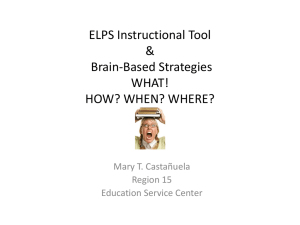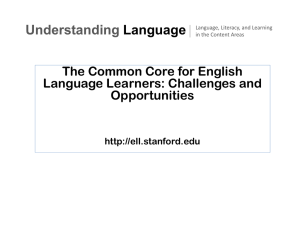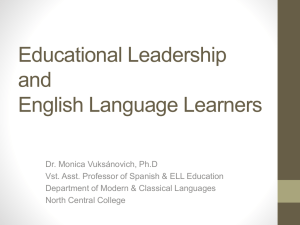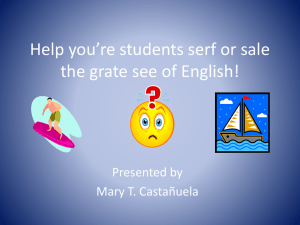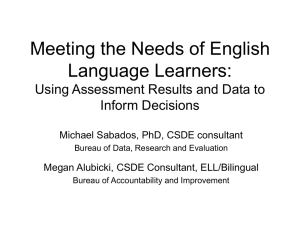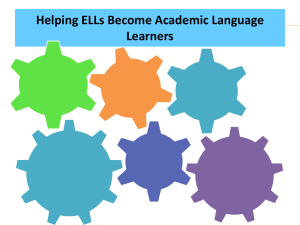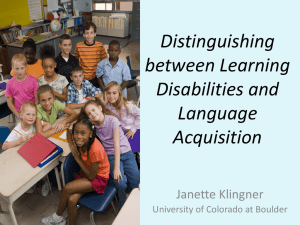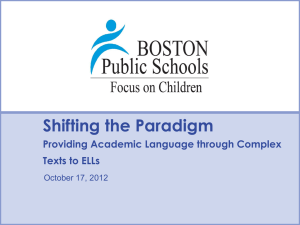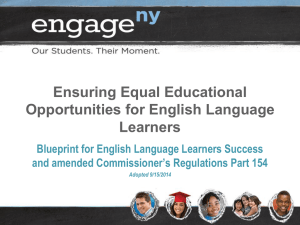Educational Leadership with an ELL Focus
advertisement
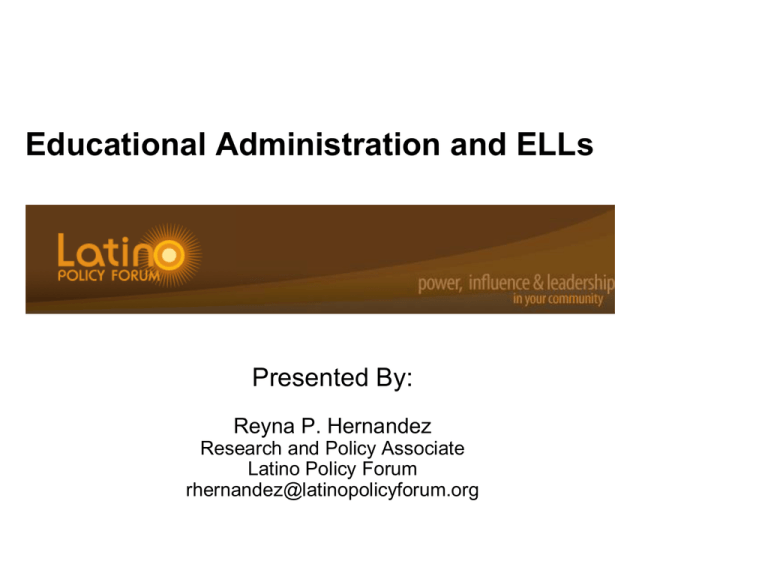
Educational Administration and ELLs Presented By: Reyna P. Hernandez Research and Policy Associate Latino Policy Forum rhernandez@latinopolicyforum.org Why we need to learn about ELLs specifically • Meeting our charge of serving ALL children requires specific knowledge of the needs of ELLs • Demographics make ELLs relevant to all administrators statewide • ELLs are a specifically identified subgroup with various associated legal obligations ELLs require specific knowledge Appropriately addressing ELLs requires a breadth & depth of knowledge. ELL Specialized Knowledge New Initiatives Gifted & Magnet Special Education Specialist Services Parent Engagement Assessment Professional Dev. Classroom Management Issues pertaining to ELLs cut across all aspects of administration and education including: – – – – – • Instruction Curriculum • Broad Administrative Knowledge of ELLs Learning Objectives: Content Knowledge AND Language Development Curriculum & Instruction Assessment Teacher Preparation & Professional Development Parent Engagement Appropriately addressing ELLs within each area requires the deliberate presence of specialized knowledge, including specific strategies and methods for serving ELLs (possibly through ELL specialist representation on project teams) Who and Where are ELLs? In SY 2009: • Nearly 200,000 ELLs were served in 573 SDs throughout IL, with 2/3rds outside of SD 299 (Chicago Public Schools) • Of the 141 languages spoken by IL ELLs, Spanish was the most spoken (80.5%), followed by Polish, Arabic, Urdu, Tagalog, Korean, Gujarati, Cantonese, Vietnamese, & Russian. ELLs receiving services are relatively young ELLs relative to total population Total Pop 9.3% ELL/LEP 90.7% Non-ELL 0% 10% 20% 30% 40% 50% 60% 70% 80% 90% 100% 100.0% 90.0% 80.0% 70.0% 60.0% Non-ELLs 50.0% LEP/ELL 40.0% 30.0% 20.0% 10.0% 9% 20% 18% 18% 15% 11% 9% 8% 6% 5% 4% 3% 3% 2% 4 5 6 7 8 9 10 11 12 0.0% Pre-K K 1 2 3 About the Foreign-Born Pop. According to the Census American Community Survey 2009: About children with foreignborn parents •While 97% of all children in IL are U.S.-born •Over a quarter (25.5%) have at least 1 foreignborn parent •Including 23.4% of U.S. Citizen children •In Chicago, over a third of all children (36.6%) have at least 1 FB parent. Indicator ForeignBorn Native % of Total Population 13.5% 86.5% Average Household Size 3.4 2.51 Married Family Households 60.5% 46.5% Less than HS diploma (≥ 25 years old) 30.6% 9.9% At least some college (≥ 25 years old) 45.1% 62.2% Births within 12 months 22.1% 77.9% Speak English “less than very well” 55.2% 1.8% Work in production/construction-type occupations (all/female) 32.3/17.3% 18.3/5% Poverty rates for families w/ children 18.5% 14.9% No health insurance 32.6% 10.3% Median Family Income $55,793 $69,253 The Law of Educating ELLs • Equal Educational Opportunities Act (EEOA), Section 1703(f) a school district must provide services that will enable limited English proficient students to “overcome barriers that impede equal participation by these students in the district’s instructional programs” (see 20 USC 1703) • Elementary and Secondary Education Act – Title III - 'English Language Acquisition, Language Enhancement, and Academic Achievement Act'. “Sec. 3102 (1) to help ensure that children who are limited English proficient, including immigrant children and youth, attain English proficiency, develop high levels of academic attainment in English, and meet the same challenging State academic content and student academic achievement standards as all children are expected to meet” • Illinois School Code Article 14C – Transitional Bilingual Education “105 ILCS 5/14C-1 … Therefore, pursuant to the policy of this State to insure equal educational opportunity to every child, and in recognition of the educational needs of children of limited English-speaking ability, it is the purpose of this Act to provide for the establishment of transitional bilingual education programs in the public schools, to provide supplemental financial assistance to help local school districts meet the extra costs of such programs, and to allow this State to directly or indirectly provide technical assistance and professional development to support transitional bilingual education programs statewide.” • Illinois Administrative Code Title 23 Part 228 – Transitional Bilingual Education – Identification of Eligible Students – Data Collection – Program Options & Placement – Assessment – Personnel Qualifications and Professional Development – Program Evaluation Educational Leadership with an ELL Focus Presented by Harriette E. Herrera DePaul University What We Need to Address • IHE and their faculty need to develop, expand and promote coursework that encompasses a strong foundation of knowledge coupled with academic pedagogy. • Courses should include clinical experiences that address the multifaceted opportunities and challenges they will encounter when working with ELL students and their families. • In addition, an understanding the role social justice plays in this arena needs to be identified, developed and applied. What We Need To Address • Our state is moving boldly by creating new requirements for certificated staff working in our education system • One thing is clear: the status quo is no longer acceptable. • IHE will need to examine how the education of ELLs is incorporated and presented in the coursework and programs designed to develop administrative leaders. • Thoughts and suggestions to consider as you review and revise the material you will be presenting to your principal candidates. Characteristics and Considerations Principal Preparation Courses Should Address • ELLs belong to a group that covers all of the age spans found in our school systems • ELLs are not a monolithic group: the characteristics of this group are often over-generalized and under-served because of the lack of factual knowledge concerning pedagogical issues related to the development of academic language,literacy and cognitive development. • Current changes in demographics throughout our state, indicate that serving ELL school aged populations cannot be seen as only an urban problem. • Diversity takes on many forms in this group in terms of language,culture, race, religion, socio-economic status and educational background. Characteristics and Considerations, Cont’d. Academic courses for principals need to include, minimally, an overview of the following areas: • Overview of what it means to be a bilingual and bicultural student as it relates to the student’s social, cultural, linguistic, emotional and intellectual background. • Language development including the role the first language plays in the acquisition and transference of knowledge to a second one • Second language acquisition, including both the social and academic language needed to be developed for success in a school setting • Knowledge of effective and best instructional practices for ELLs • Familiarity with the models used to deliver instruction to ELLs and the corresponding academic outcomes when using such models • Understanding of how social and political forces affect public education and how to be an advocate for your students and families • Being able to separate facts from myths about learning English as a second language. Characteristic and Considerations contd. Attention should also be given to the following areas as they relate specifically to the ELL student population in their school. • Staff Evaluation • Instructional Delivery • Classroom Materials • Curriculum • Assessments • Review, analyze and use data for decision-making purposes • Monitor student progress • Be able to identify which instructional and program models meet student academic and social/emotional needs • How to measure the effectiveness of the instructional program • Staff performance • Professional development for all staff working with the students and families Connecting Theory to Practice • At least some of the courses for principal preparation must include clinical hours • While completing the internship, programs should provide placements where they can acquire experience working in a school/district where ELLs are being served • Clinical hours and/or internship must be designed so they gain experience working with staff, students and parents in a variety of contexts as they relate to ELLs Online Resources and Recommended Websites • Division of English Language Learning (DELL Division) of the Illinois State Board of Education (http://isbe.net/bilingual) • WIDA Consortium World-class Instructional Design and Assessment (http://www.wida.us): Home page of the Consortium Illinois belongs to for English language proficiency standards and the identification and annual assessment used to measure ELL English language proficiency: • National Clearinghouse for English Language Acquisition (http://www.ncela.gwu) • Center for Applied Linguistics (http://www.cal.org): Operated by the Center for Applied Linguistics (CAL), the ERIC Clearinghouse on Languages and Linguistics (ERIC/CLL) collects and disseminates information on current developments in education research, instructional methods and materials, program design and evaluation, teacher training, and assessment of several language and linguistic areas. Websites for Reference, Guidance and Research • The University of California's Center for Research on Education, Diversity & Excellence (CREDE) (http://crede.berkeley.edu/) focuses its research and development on critical issues in the education of linguistic and cultural minority students and those placed at-risk by factors of race, poverty, and geographic location • Consortium for Language Policy and Planning http://ccat.sas.upenn.edu/plc/clpp/ • Institute for Language Education Policy http://www.elladvocates.org/ • Language Policy Research Unit, Arizona State University http://www.asu.edu/educ/epsl • Reading Rockets www.readingrockets.org; the Spanish version: Colorin/Colorado http://www.readingrockets.org/spanish • Early Childhood Research Institute on Culturally and Linguistically Appropriate Services (CLAS) http://clas.uiuc.edu/ Scholars, Researchers and Expert Sources for Studies and Publications about ELLs • James Crawford’s Website: http://www.languagepolicy.net • Nancy Commins: http://www.ucdenver.edu/academics/colleges/SchoolOfEducation/ FacultyandResearch/Pages/NancyCommins.aspx • Jim Cummins ESL and Second Language Learning Web: http://www.iteachilearn.com/Cummins • Kathy Escamilla: http://nepc.colorado.edu/author/escamilla-kathy • Eugene Garcia: https://webapp4.asu.edu/directory/person/489623 • Fred Genesee’s website: http://www.psych.mcgill.ca/perpg/fac/genesee/fredad.html • Kenji Hakuta’s website: http://www.stanford.edu/~hakuta/ • Jill Kemper Mora’s website: http://coe.sdsu.edu/people/jmora/ • Sonia Nieto’s homepage: http://sonianieto.com/ Suggested Textbooks • One Child, Two Languages: A Guide for Early Childhood Educators of Children Learning English as a Second Language. Second edition, Tabors, Patton O. (2008) • How Languages are Learned, third revised edition, Patsy M. Lightbown, Nina Spada, authors. • Literacy Instruction for English Language Learners Cloud, N., Genesee, F., Hamayan,E. (2009).. Portsmouth, NH: Heinemann • Teaching Reading in Multilingual Classrooms Freeman, David E. and Yvonne S., (2000).. Portsmouth, NH: Heinemann • Teaching Reading to English Language Learners: Differentiated Literacies Herrera,S.G., Perez,D.R., and Escamilla, K. (2010). Boston, MA: Allyn & Bacon • Between Worlds: Access to Second Language Acquisition David E. Freeman and Yvonne S. Freeman, 2001 Suggested Textbooks, cont’d. • Educating English Language Learners-Language Diversity in the Classroom James Crawford,2004 • Young ELLs: Current Research and Emerging Directions authors, Eugene Garcia and Ellen Rede, 2010 • Forbidden Language, Patricia Gandara, 2010 • Myths and Realities, Second Edition Best Practices for English Language Learners , Katharine Davies Samway and Denise Mc Keon • Not for ESOL Teachers: What Every Classroom Teacher Needs to Know About the Linguistically, Culturally, and Ethnically Diverse Student, 2/Edition Eileen N. Whelan Ariza • Literacy, Technology and Diversity: Teaching for Success in Changing Times, Jim Cummins, Kristin Brown, Dennis Sayers, 2007 Don’t Get Lost in the Fog You’ll find “the light on” when you tap into these great resources : The Illinois Resource Center http://www.thecenterweb.org/irc/ The Illinois State Bilingual Conference held in December Faculty from the IHE Bilingual/ESL Departments The Illinois Bilingual Advisory Council The Cultural and Linguistic Diversity Committee of the IL Early Learning Council, ILELC The Joint Workforce/Linguistic Diversity Workgroup of ILELC, Faculty Forum And you can always contact me, Harriette Herrera at hherrera@depaul.edu or my preferred e-mail, harrietteherrera@mac.com

